















Nash Metropolitan |
|---|
|
| Topic Navigation |
|---|
|
Wikipedia: Nash Metropolitan
Page Sections History Images |
History
The following section is an excerpt from Wikipedia's Nash Metropolitan page on 6 May 2018, text available via the Creative Commons Attribution-ShareAlike 3.0 Unported License.
The Nash Metropolitan was an American automobile that was sold from 1953 to 1961.
It conforms to two classes of vehicle: economy car and subcompact car. In today’s terminology the Metropolitan is a “subcompact”, but this category had not yet come into use when the car was made. At that time, it was variously categorized, for example as a "small automobile" as well as an "economy car".
The Metropolitan was also sold as a Hudson when Nash and Hudson merged in 1954 to form the American Motors Corporation (AMC), and later as a standalone marque during the Rambler years, as well as in the United Kingdom and other markets.
While most U.S. automobile makers were following a "bigger-is-better" philosophy, Nash Motor Company executives were examining the market to offer American buyers an economical transportation alternative. The Metropolitan was designed in the U.S. and it was patterned from a concept car, the NXI (Nash Experimental International), that was built by Detroit-based independent designer William J. Flajole for Nash-Kelvinator. It was designed as the second car in a two car family, for Mom taking the kids to school or shopping or for Dad to drive to the railroad station to ride to work: the "commuter/shopping car" with resemblance to the big Nash, but the scale was tiny as the Met's wheelbase was shorter than the Volkswagen Beetle's.
The NXI design study incorporated many innovative features, and attempted to make use of interchangeable front and rear components (the symmetrical door skins were the only interchangeable items that made it into production). Although more complex, the new vehicle also incorporated Nash's advanced single-unit (monocoque) construction. It was displayed at a number of "surviews" (survey/previews), commencing on 4 January 1950 at the Waldorf-Astoria Hotel, New York, to gauge the reaction of the American motoring public to a car of this size. The result of these surviews convinced Nash that there was indeed a market for such a car, if it could be built at a competitive price.
A series of prototypes followed that incorporated many of the improvements from the "surviews" that included roll-up glass side windows, a more powerful engine, and a column-mounted transmission shifter with bench seat (rather than bucket-type seats with floor shift fitted in the concept car). The model was named NKI (for Nash-Kelvinator International), and it featured revised styling incorporating a hood blister and rear wheel cutouts.
Nash was positioning this new product for the emerging postwar market for "personal use" autos. These specific use vehicles were as a second car for women or an economical commuter car. The Metropolitan was also aimed at returning Nash to overseas markets. However, Mason and Nash management calculated that it would not be viable to build such a car from scratch in the U.S. because the tooling costs would have been prohibitive. The only cost-effective option was to build overseas using existing mechanical components (engine, transmission, rear end, suspension, brakes, electrical), leaving only the tooling cost for body panels and other unique components.
With this in mind, Nash Motors negotiated with several European companies. On October 5, 1952, they announced that they had selected the Austin Motor Company (by then part of BMC) and Fisher & Ludlow (which also became part of BMC in September 1953, later operating under the name Pressed Steel Fisher), both English companies based in Birmingham, England and vicinity. Fisher & Ludlow would produce the bodywork, while the mechanicals would be provided, as well as final assembly undertaken, by the Austin Motor Company. This was the first time an American-designed car, to be exclusively marketed in North America, had been entirely built in Europe. It became a captive import – a foreign-built vehicle sold and serviced by Nash (and later by American Motors) through its dealer distribution system. It is believed that the first pre-production prototype was completed by Austin on December 2, 1952. In all, five pre-production prototypes were built by Austin Motors and tested prior to the start of production. The total tooling cost amounted to US$1,018,475.94, (Austin: US$197,849.14; Fisher & Ludlow: US$820,626.80) which was a fraction of the tooling cost for a totally U.S.-built vehicle.
The styling for all Nash vehicles at that time was an amalgam of designs from Pininfarina of Italy and the in-house Nash design team. The different models from Ambassador down to the Metropolitan utilised very similar design features (fully enclosed front wheels, notched "pillow" style door pressing, bar style grille etc.). Whilst Nash used the fact that styling was by Pininfarina in their advertising for their larger models, Pininfarina refused to allow his name to be associated with the Metropolitan as he felt it would damage his reputation with other Italian car companies to be linked to such a small car.
The new Metropolitan was made in two body designs: convertible and hardtop. All came with several standard features that were optional on most cars of the era. Among these factory-installed benefits for customers were a map light, electric windshield wipers, cigar lighter, and even a "continental-type" rear-mounted spare tire with cover. To give a "luxury" image to the interior, "Bedford cord" upholstery trimmed with leather was used (similar to larger Nash vehicles). An AM radio, "Weather Eye" heater, and whitewall tires were offered as optional extras for the U.S. market. (It is unlikely that a Metropolitan could have been purchased without a heater and radio, as all vehicles left the factory with both items fitted.)
The Metropolitan was the first postwar American car that was marketed specifically to women. The Dodge La Femme was introduced one year later. The first spokesperson for the car was Miss America 1954, Evelyn Ay Sempier, and the car was prominently advertised in Women's Wear Daily. American Motors' marketing brochures described the new model as "America's entirely new kind of car" (1955), "Luxury in Miniature" (1959), and "crafted for personal transportation" (1960).
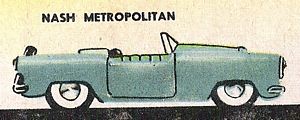 |
Subject: Nash Metropolitan Drawing from Premier Model Kit Box
View Nash Metropolitan Drawing - 162KB |
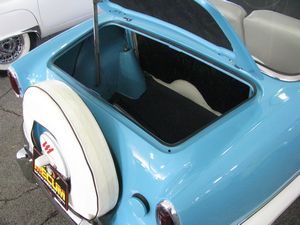 |
Subject: 1959 Nash Metropolitan 1489cc Coupe
Photographer: Bill Crittenden Event: Mecum 2012 Fall Premier Auction Auction Info: Sold for $12,500. Additional Info: Complete Frame-Off Restoration, BMC B-Series 1489cc 4-cylinder engine (55hp) & 3-speed transmission View photo of 1959 Nash Metropolitan 1489cc Coupe - 3.4MB |
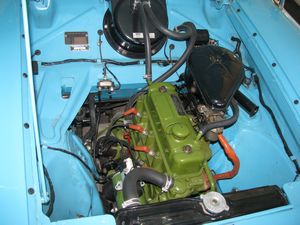 |
Subject: 1959 Nash Metropolitan 1489cc Coupe
Photographer: Bill Crittenden Event: Mecum 2012 Fall Premier Auction Auction Info: Sold for $12,500. Additional Info: Complete Frame-Off Restoration, BMC B-Series 1489cc 4-cylinder engine (55hp) & 3-speed transmission View photo of 1959 Nash Metropolitan 1489cc Coupe - 3.9MB |
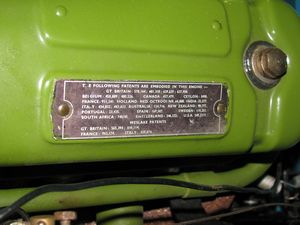 |
Subject: 1959 Nash Metropolitan 1489cc Coupe
Photographer: Bill Crittenden Event: Mecum 2012 Fall Premier Auction Auction Info: Sold for $12,500. Additional Info: Complete Frame-Off Restoration, BMC B-Series 1489cc 4-cylinder engine (55hp) & 3-speed transmission View photo of 1959 Nash Metropolitan 1489cc Coupe - 3.2MB |
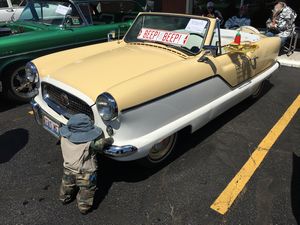 |
Subject: 1960 Nash Metropolitan
Photographer: Bill Crittenden Event: 2018 Gilberts Spring Car Show View photo of 1960 Nash Metropolitan - 3.2MB |
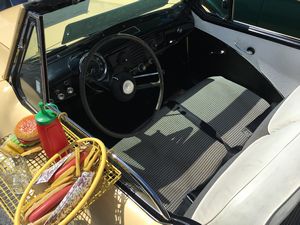 |
Subject: 1960 Nash Metropolitan
Photographer: Bill Crittenden Event: 2018 Gilberts Spring Car Show View photo of 1960 Nash Metropolitan - 3.2MB |
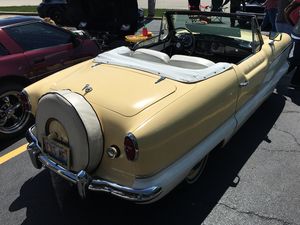 |
Subject: 1960 Nash Metropolitan
Photographer: Bill Crittenden Event: 2018 Gilberts Spring Car Show View photo of 1960 Nash Metropolitan - 2.7MB |
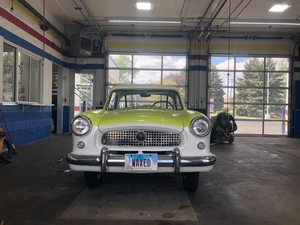 |
Subject: Nash Metropolitan
Photographer: Bill Crittenden Location: Fast Eddie's in Huntley, Illinois View photo of Nash Metropolitan - 2.7MB |
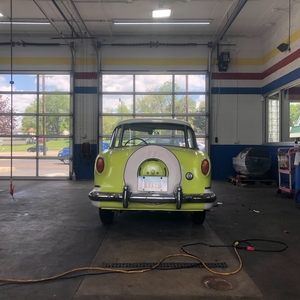 |
Subject: Nash Metropolitan
Photographer: Bill Crittenden Location: Fast Eddie's in Huntley, Illinois View photo of Nash Metropolitan - 1.9MB |
